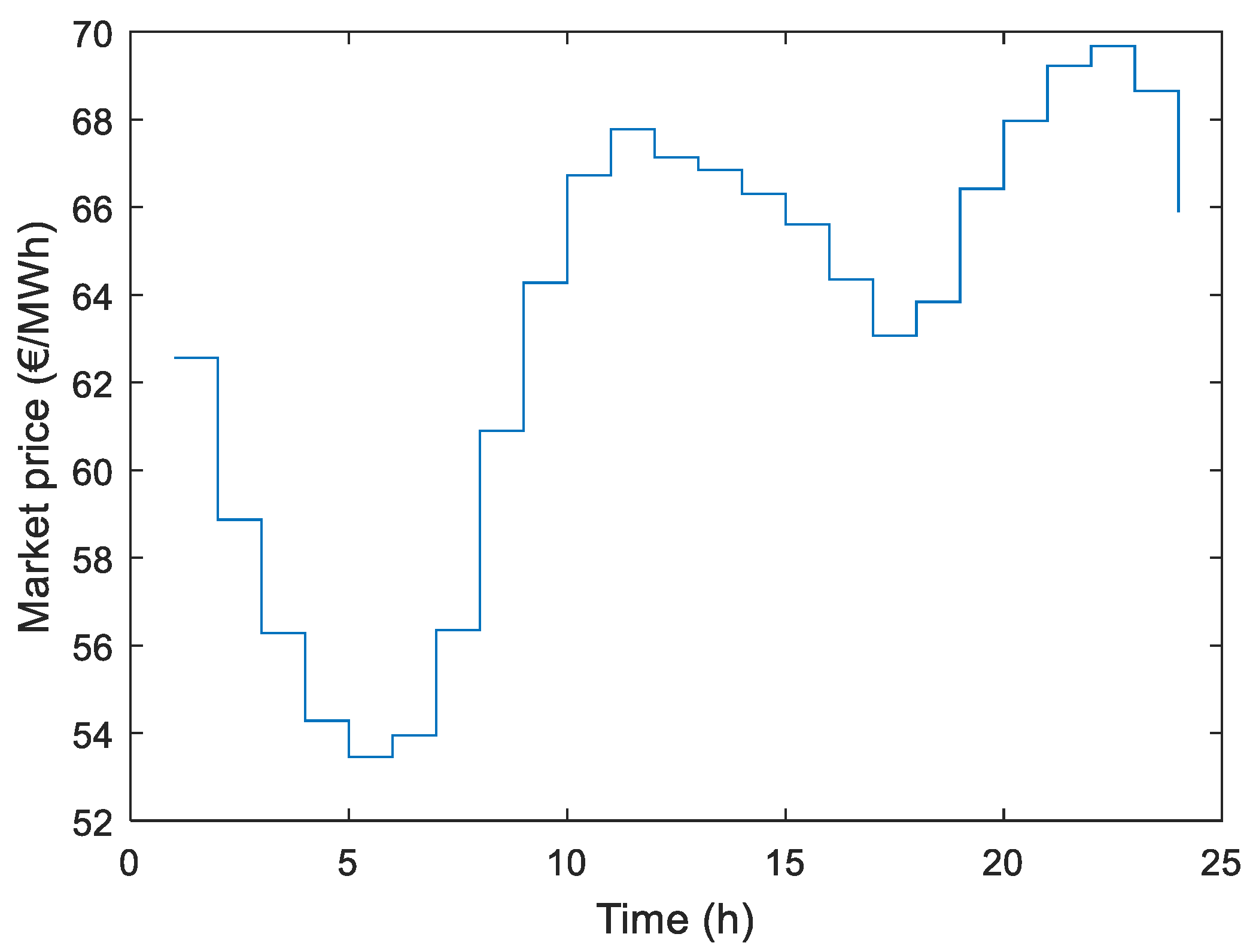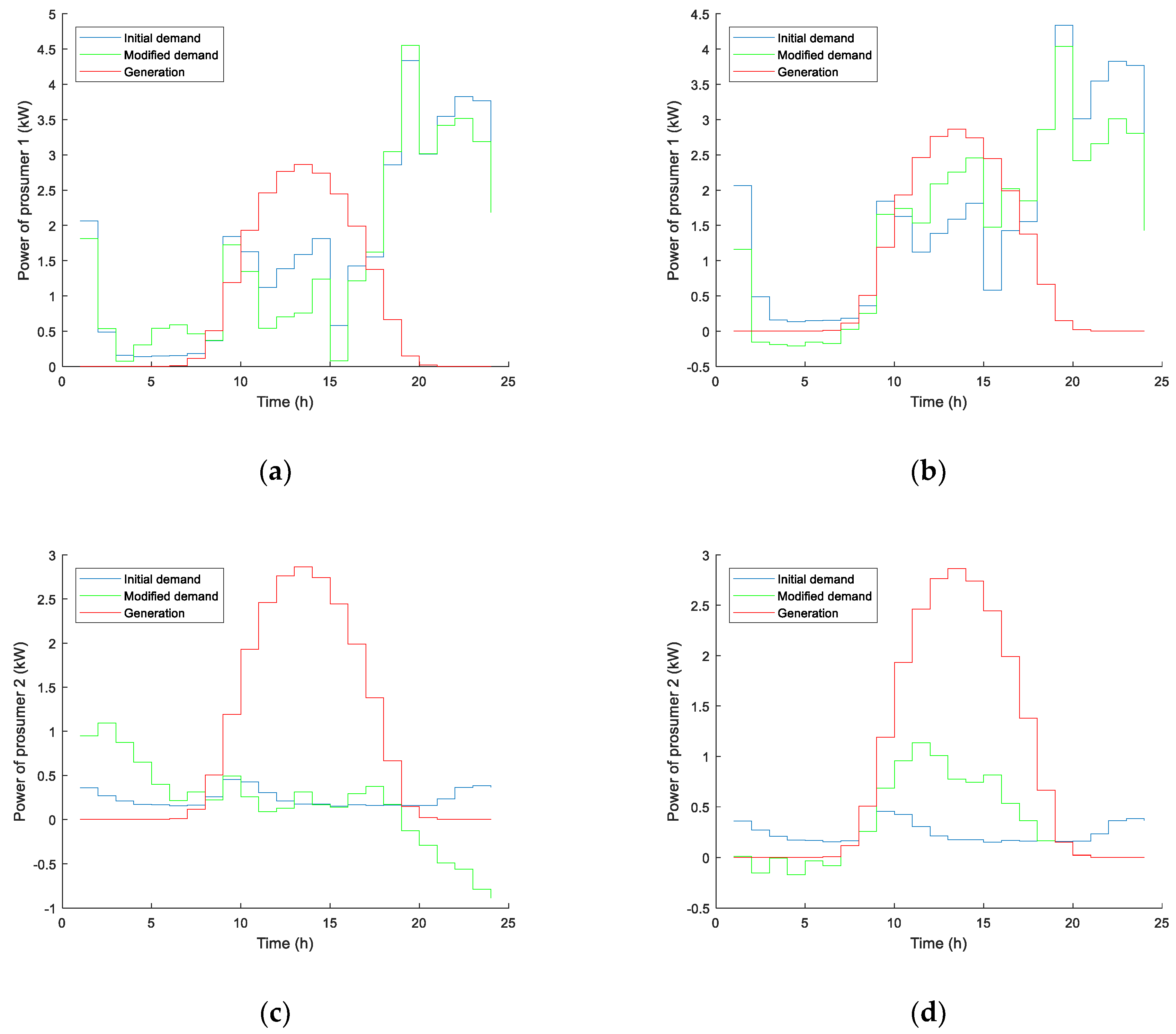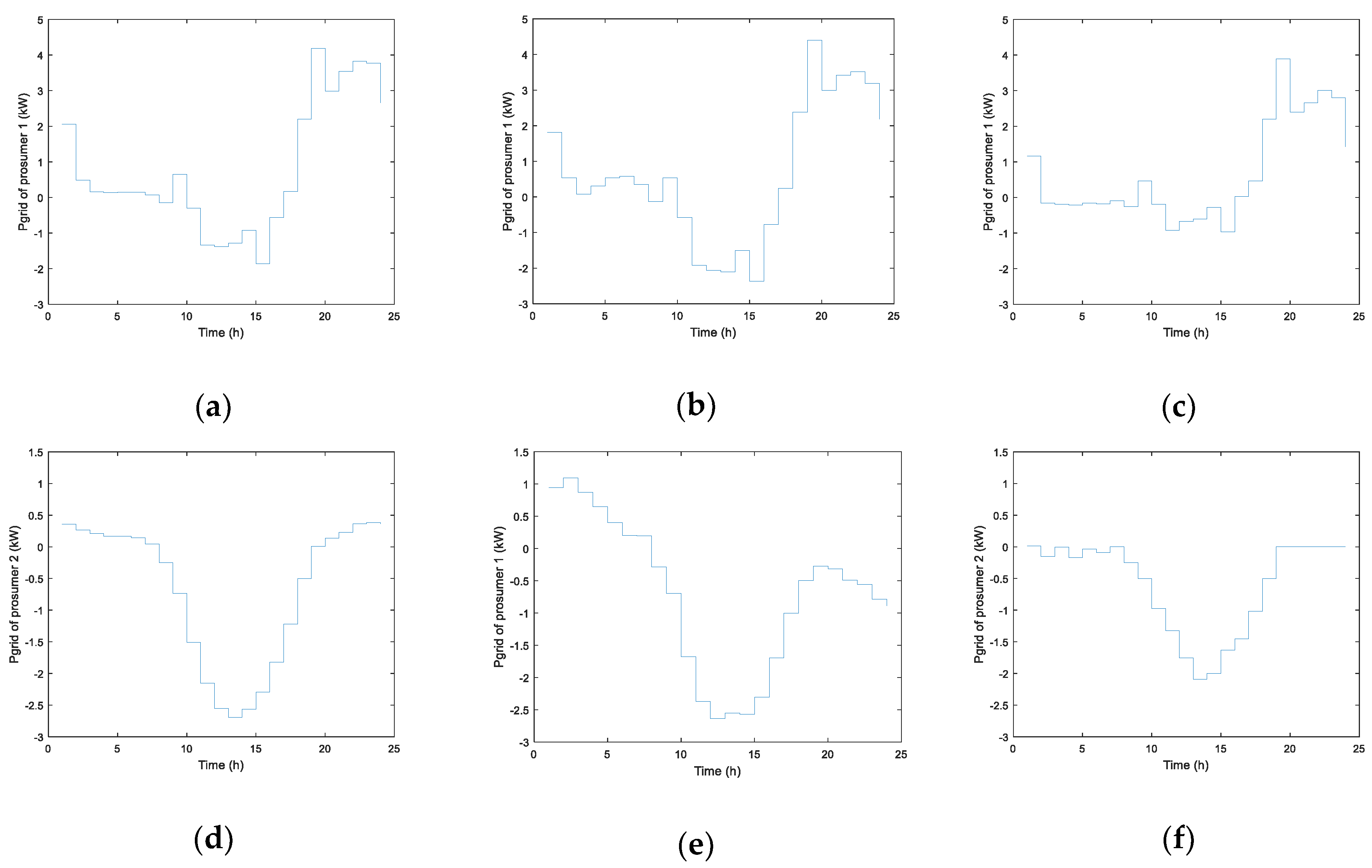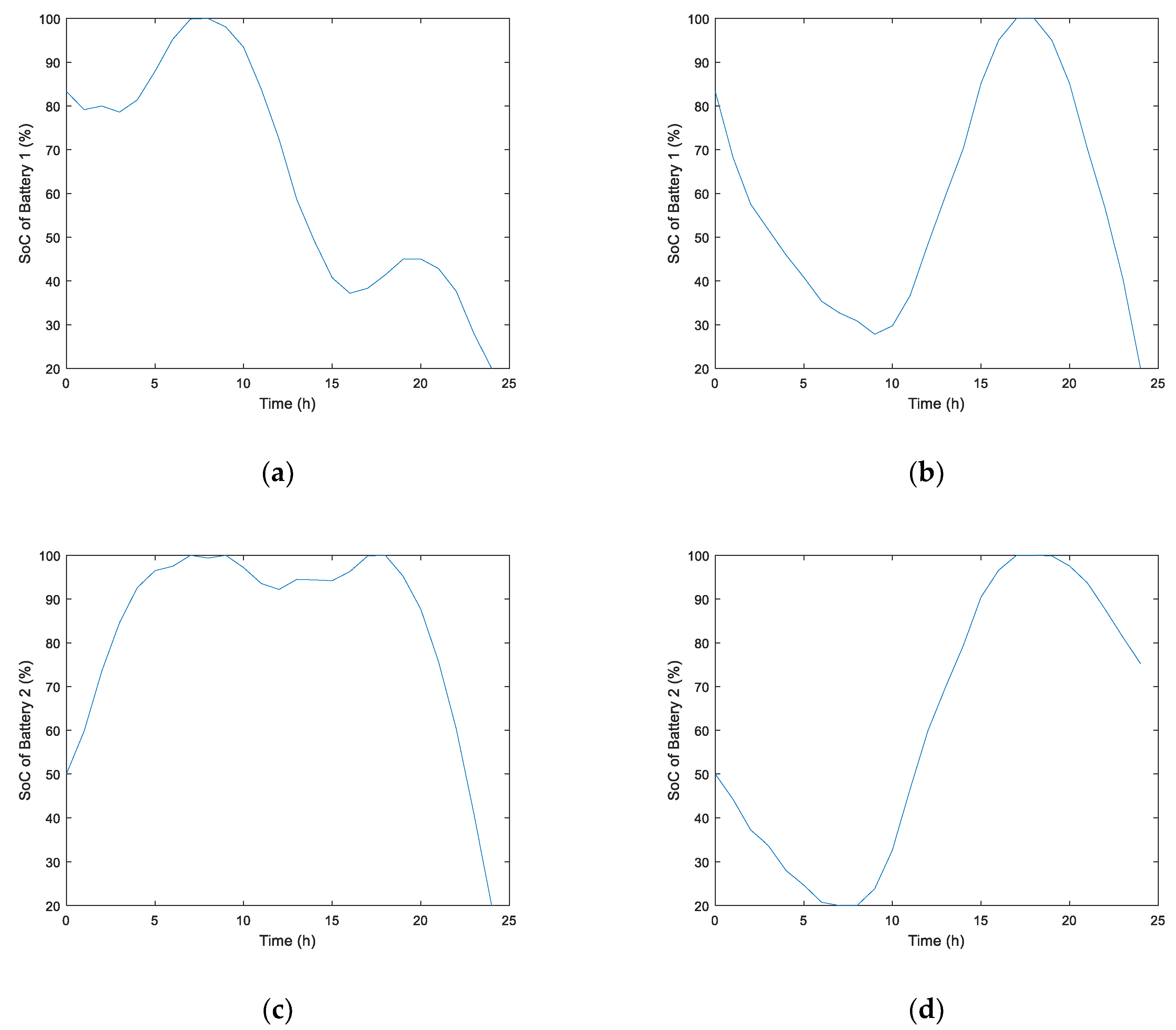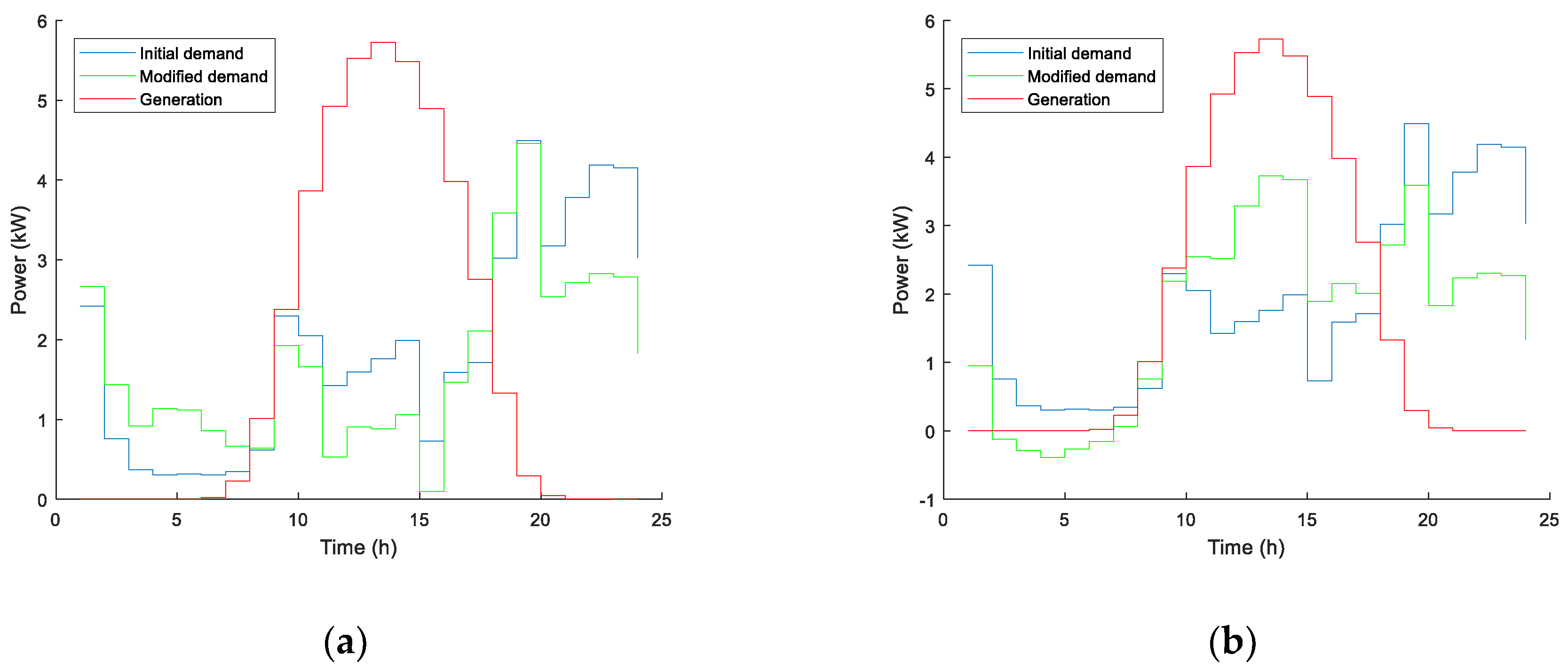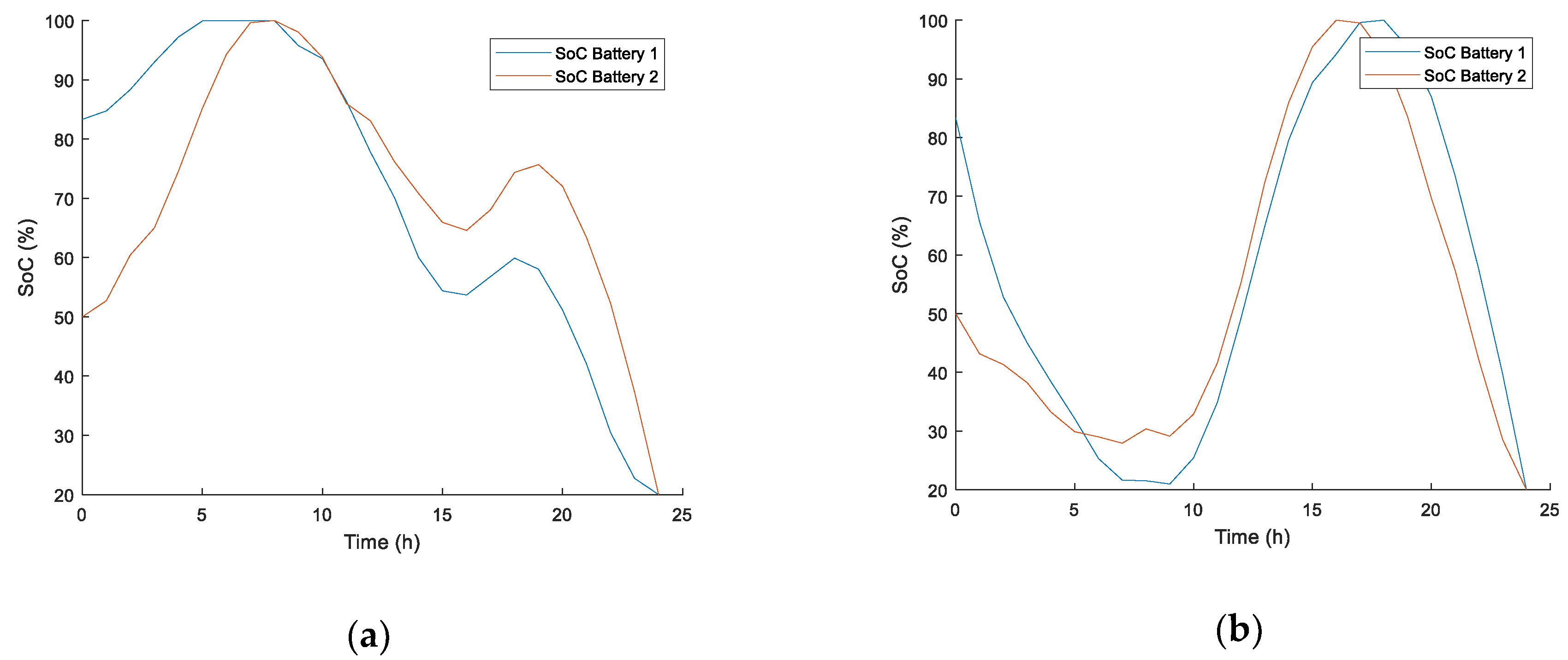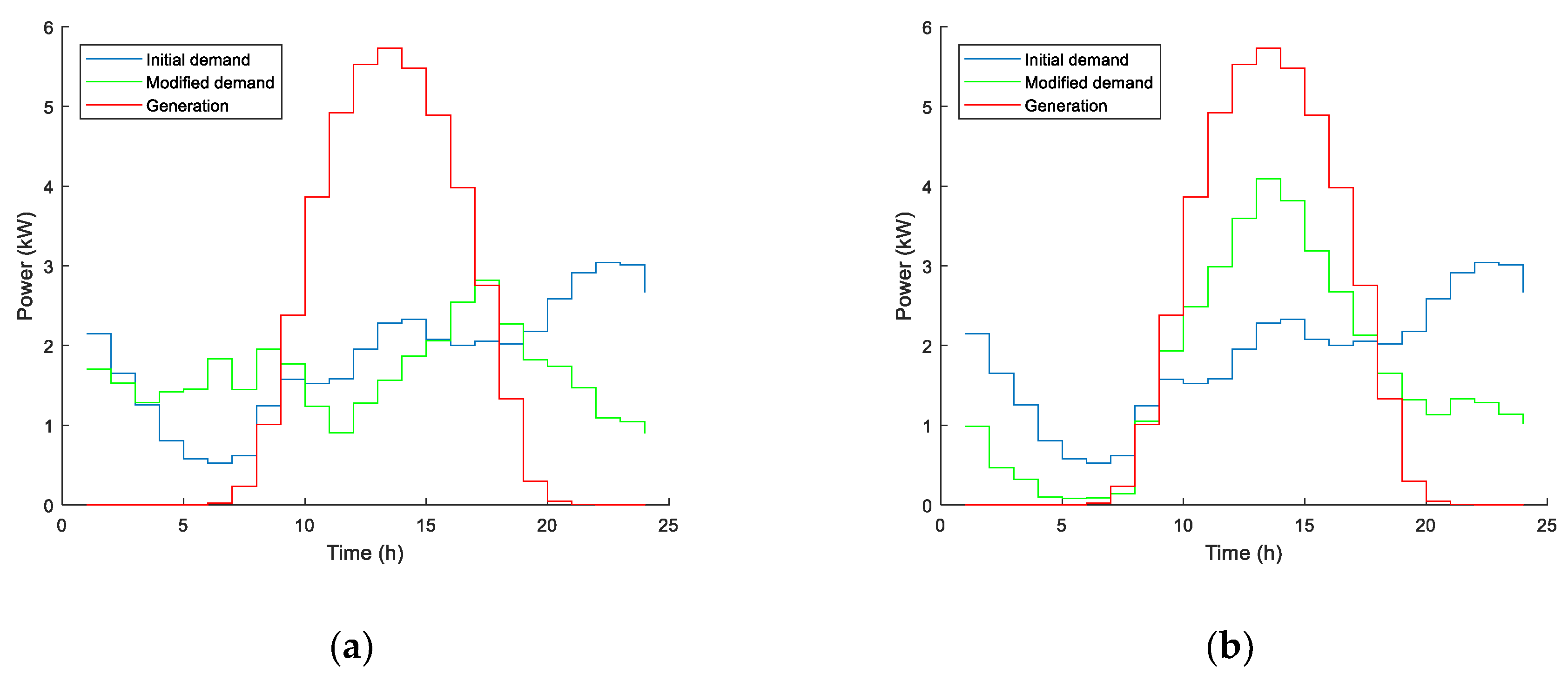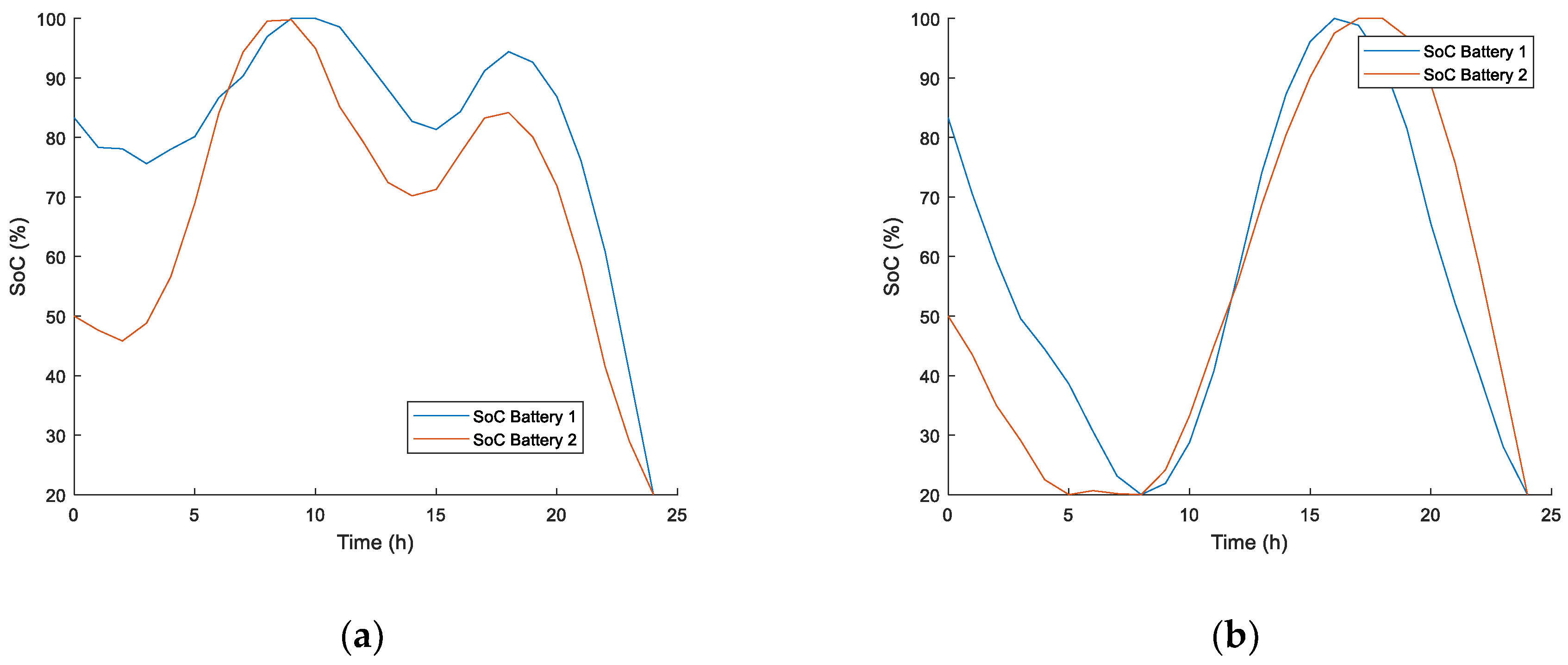1. Introduction
Within a context of reinforcing consumers’ roles in the energy system and improving energy efficiency in Europe [
1], the concept of prosumer has become common in the power system context. A prosumer is a consumer with the ability of producing electric energy to be either self-consumed or injected into the grid. A group of prosumers connected and coordinated to manage their energy resources are considered to be a microgrid [
2]. The microgrid can be either isolated or grid-connected, in which energy management and economic profitability are the main targets.
Many studies can be found in literature analyzing microgrids’ financial feasibility and the correct sizing of their respective Distributed Energy Resources (DERs) [
3,
4]. In most of the published works the main objective of the microgrid energy management system is to achieve the highest possible economic benefit by minimizing its operational costs [
5,
6]. Generation costs [
6] and market prices, for the purchased/sold energy [
5], are used to define optimization techniques’ objective functions. However, economic incentives and additional costs have a great importance in the microgrids’ financial sustainability and they must be considered in their design and operation [
3]. Incentives are due to advantages of self-consumption improvement, that lie on empowering consumers by means of their participation in energy management programs, encouraging smarter consumption patterns, reducing peak demand and energy costs, decreasing transmission losses, due to the local generation and consumption, and contributing to finance energy transition [
7].
Household prosumers usually count on locally available renewable energy generation, which, in most cases, is enabled by photovoltaic (PV) systems located at the dwellings [
8]. In many countries, the decreasing cost of PV system devices has led to a grid-parity in self-generated PV energy in comparison to energy purchased from the grid. In this context, self-consumption achieves economic sustainability, even without financial support from governments.
Under deregulated electricity markets, extended all over Europe, general costs of power systems for building and operating infrastructures are covered by network tariffs and taxes. Network tariffs can be composed by two possible components: volumetric tariffs, according to which consumers pay per unit of purchased energy (€/kWh); and capacity tariffs, applied to the power capacity contracted with the energy provider (€/kW). In both cases tariffs can be classified as flat type, variable with consumption or capacity level and time-of-use type (different tariffs in peak/off-peak hours) [
7]. Higher volumetric tariffs motivate for demand reduction, by means of energy efficiency and self-consumption. On the other hand, predominant capacity tariffs lead to peak-shaving.
Regarding energy prices, they are based on a spot market where a clearing price is obtained by the point at which the supply and demand curves meet, according to the European algorithm EUPHEMIA [
9]. This market price establishes both purchase and sale prices for consumers and producers, respectively. In addition, the undeniable interest to increase the penetration of energy conversion systems based on renewable primary energy resources and the related motivation to improve self-consumption ratios has led to several promotion policies in different countries. An interesting classification of common incentives to introduce renewable energy resources can be found in [
10]. According to this work, promotion policies can be focused on investment or on energy generation, but the most common type of policies in Europe are related to feed-in tariffs (FIT). There are two types of FIT systems: fixed and premium [
7,
10]. The first one is independent on the electricity market price, facilitating the assumption of investment risks, whereas the second one is an overprice above market price, with the advantage of being attached to the market behavior and thus avoiding excessive remuneration for producers and market distortion [
7].
In the case of surplus energy fed into the grid, from prosumers using renewable energy resources, there is not a common understanding in the different European countries about the promotion policies. While many countries support investment or establish FIT frameworks, others prefer net metering approaches. Under this concept, the electricity excess injected into the grid can be later used during higher consumption hours, when self-generated energy is not sufficient [
7]. Therefore, the main grid acts as a backup or a virtual storage system to manage the prosumers’ energy surplus/deficit. Since energy price may be different during the hours of the day, and it is not considered in net-metering framework, this approach is commonly not favorable from the power system point of view and it is limited to small-size systems. As a consequence, some countries apply the so-called net-billing, which calculates the value of the energy fed into the grid at wholesale price to be used as a credit to purchase energy at other time period [
7]. A survey of policies in European countries can be found in [
7], although some of them have experienced variations during the last years.
Promotion policies make sense while immature technologies are trying to be introduced or while their marginal costs, when compared to conventional generation systems, do not allow them to participate in a competition market with equal conditions. The natural trend for any promotion policy is to converge into a market approach when grid-parity has been reached.
The case of Spain has been singular both in renewable energy, mainly PV, and in self-consumption promotion policies. The installation of renewable technologies and, especially, PV plants, was strongly boosted from 2007 to 2012, under high incentives in the form of fixed and premium FIT. In 2012 a high so-called “tariff-deficit” was reached which led to the extinction of support schemes for new plants and to changes in remuneration for existing plants, causing financial issues to many investors [
11]. PV power plants were primarily promoted during the former years 2007 and 2008 which led to an extraordinary proliferation of this kind of generation systems and improved the experience and background of Spanish renewable energy companies all over the world. Since 2012, new PV power plants can only compete for extra economic support under a capacity-based aid to recover investment [
12]. Regarding self-consumption, former regulation [
13] stablished a specific cost to be paid as a consequence of self-consumed energy. Only low-voltage low-power prosumers who did not feed surplus energy into the grid were exempted from paying that specific cost. Additionally, self-consumption installations and energy could not be shared among prosumers, preventing the development of prosumers communities. This policy strongly discouraged the investment in new self-consumption installations. The situation has recently changed by means of a new law [
14], which exempts self-consumed energy from paying any extra cost regardless of whether the prosumer feeds the excessive energy into the grid or not. Moreover, energy management can already be shared within a community. Therefore, in the absence of further regulation, current economic situation for Spanish prosumers can be summarized as the possibility of purchasing or selling energy from/to the power system at market price (no energy-based aids are planned for generated energy). In addition, payment of network tariffs for energy fed into or demanded from the grid must be paid, but no extra costs for self-consumed energy. Also, either individual or shared management are possible.
In order to maximize the advantage of self-consumption for end users, flexibility to match generated energy with demanded one is essential. This flexibility can be achieved by means of two possible mechanisms: demand-side response (DSR) and/or energy storage systems (ESS). The first one had a wide attention in literature [
15,
16]. As household electricity demand has a limited potential to apply restrictive DSR programs, the work described in this paper is focused on ESS usage instead, whose operation is scheduled according to different targets.
The role of ESS in microgrids is usually related to peak shaving [
3], leading to a reduction of distribution system costs, which are based on the available power capacity instead of the volume of circulating energy. Other classical target is to mitigate fluctuation of PV generation [
8] or other intermittent renewable energy source. ESS scheduling with economic target within a microgrid has also been discussed in literature [
5,
6,
17,
18]. Choi et al. [
5] schedule a unique ESS to minimize traded energy cost based on energy price. In [
6], the authors schedule batteries aiming at microgrid energy generation cost minimization, with no grid interchange. Both energy sale/purchase prices and operation and maintenance (O&M) costs of DERs are used in the optimization process in [
17], although O&M costs of every DER (both renewable generation and ESS) are considered equal in this paper. Depreciation and environmental costs are also added to objective function in [
18], being their values obtained from previous published papers. In all these works optimal ESS scheduling is performed and evaluated considering energy price as the only economic parameter to be considered in the interconnection of the microgrid with the main grid, i.e., to authors’ knowledge, no previous work considers network tariffs to evaluate the economic advantages of an ESS scheduling method.
On the other hand, the coordination of several storage systems, owned by different prosumers, is not usually considered within a microgrid’s common energy management strategy. The concept of “peer-to-peer (P2P)” supply [
19,
20] explains energy sharing within a community of prosumers. However, in these works, P2P supply is provided only by the generation surplus, without the involvement of stored energy. A wide review of possibilities of grouping prosumers as a community can be found in [
21], which reveals that the common objectives of these communities are to maximize distributed production, to minimize losses or to optimize revenues. According to [
21,
22], further research is required in the area of prosumers’ objectives and motivations.
The main goal of the present work is to evaluate the advantages of scheduling microgrid’s ESS with an objective function based on minimizing generation-demand mismatch within the microgrid (thus minimizing energy exchange with the main grid) when compared to classical cost minimization. Benefits are observed for both prosumers, with PV generation and ESS, and the main grid. The case study is focused on a community of prosumers under Spanish regulation. Besides the expected advantages related to self-consumption, self-sufficiency and peak shaving, also economic benefits are achieved using the proposed objective function, because it reduces the prosumers electricity bill, at least in the absence of energy-based incentives, and better preserves battery lifetime. The economic evaluation of a scheduled optimization process that does not consider economic variables in the objective function is a novel contribution of this work. Furthermore, the study has been developed aiming to prove that cooperation between community prosumers, under the concept of microgrid, improves the global economic benefit for the community, compared to an individual management.
The paper is organized as follows:
Section 2 describes the case study, the optimization methodology and the objective functions tested. Results are shown in
Section 3. Finally,
Section 4 discusses results and summarizes the conclusions.
3. Results
The performance of the proposed algorithm with the aim of comparing the different objective functions and evaluating the advantages of prosumers’ cooperation is quantified by means of usual indicators in literature. Self-consumption (SC) and self-sufficiency (SS) rates are well known indicators and they are presented in Equations (8) and (9), respectively. In both cases, the numerator computes the load instantly matched by the local production, using the considered batteries. Therefore, SC describes the percentage of on-site generation that is instantly consumed by the prosumer and SS the percentage of demand instantly satisfied by the on-site generation [
29]:
Other technical indicators to evaluate the results are the power interchanged with the main grid
Pgrid, obtained from the nodal (in individual operation) or the whole system (coordinated operation) power balance, computed by Equation (10), and the accumulated energy import
Eimp and export
Eexp during the whole day, computed by Equations (11) and (12) respectively. One must note that
Pgrid should not be higher than the line capacity (4.6 kW for each dwelling or 9.2 kW for the common supply line):
Finally, economic indicators are used to evaluate the profitability of the obtained solution for the prosumers. Based on the energy trading prices,
Costbnt denotes the energy cost before network tariffs in €/day, and is calculated by Equation (13):
Pr(
t) is the set of hourly prices of the Spanish Electricity Market (
Figure 3). According to
Pgrid sign, the cost is positive when the energy is imported.
Network tariffs have two components for consumers in Spain: a capacity-based term, Consumer Power Tariff (CPT, in €/kW·year), which is multiplied by the contracted power (CP), and a volumetric term, Consumer Energy Tariff (CET, in €/kWh). On the other hand, a volumetric term is only established for producers, Producer Energy Tariff (PET, in €/MWh). Values for these tariff terms have been obtained from Spanish regulation for low voltage consumers, with the so-called 2.0 A tariff [
30], and for any producers [
31], being CPT = 38.043426 €/kW·year, CET = 0.044027 €/kWh and PET = 0.5 €/MWh.
CP can be selected as any value of power, rounded by multiples of 0.1 kW, over the maximum demanded power [
14]. In each case, CP (kW) has been obtained for the day under study, starting from the maximum absolute value of
Pgrid.
These values have been used to calculate the daily cost of the electric energy after network tariffs
Costant by means of Equation (14):
The mentioned indicators are used to evaluate the performance of both tested objective functions (cost objective function COF and mismatch objective function MOF), to compare them with each other and with the case without ESS. Firstly, individual scheduling for each dwelling is considered, and afterwards, results are compared to the case where coordinated community management is considered.
3.1. Individual Schedule of Batteries
Taking into account the objective functions presented in
Section 2,
Figure 4 shows generation, initial demand and demand modified by the action of the batteries for both prosumers.
Table 1 shows the SC and SS indicators obtained with each of the proposed objective functions and the situation without ESS.
As it was expected, COF leads prosumers to buy energy at night (when the price is low) and to avoid buying or even to sell energy at evening peak price hours. This procedure has economic advantages in energy cost but penalizes SC and SS rates, as shown in
Table 1. These indicators are even worse with COF than those obtained without ESS in the households. On the contrary, MOF significantly improves SC and SS of both prosumers, since its main target is to match generated and demanded power as much as possible.
Figure 5 shows the power interchanged with the main grid
Pgrid, according to Equation (10). It can be observed that line capacity of each dwelling is not exceeded in any cases.
Absolute values for energy imported
Eimp and exported
Eexp (according to Equations (11) and (12) respectively), are reported in
Table 2.
Figure 5 and
Table 2 confirm the conclusion previously reached. The dependence of both prosumers on the main grid can be, when COF is used, even higher than in the absence of ESS (either in terms of power or energy). This is a consequence of considering energy price as the unique variable to perform the battery management and leads to other drawbacks, such as higher required capacity of the distribution grid and higher transmission losses. However, MOF reduces the dependence on the main grid, both in power and energy terms, thus assuring advantages also for the distribution system. The previous indicators used for evaluating the performance of the proposed objective functions are related to technical performance.
Table 3 below summarizes the economic indicators to evaluate eventual prosumer benefits.
Table 3 proves that MOF presents economic advantages as well. Although
Costbnt is obviously lower when COF is used, this approach leads to higher energy interchange with the grid, which adds costs in terms of network tariffs both when importing and exporting energy (although with different unitary cost). In the case of MOF, CP is reduced as well as imported and exported energy, leading to considerably lower network tariffs. As a consequence, this is the approach with the lowest
Costant for prosumer 1 and produces similar revenues for prosumer 2.
Additional benefits are obtained from MOF related to batteries lifetime. As discussed earlier, a higher frequency of charge/discharge cycles increases battery degradation, leading to a lifetime decrease.
Figure 6 compares batteries’ SoC evolution when the different objective functions are used. It can be observed that oscillation between charge/discharge modes is less frequent using MOF than using COF, thus contributing to slow down battery degradation.
3.2. Coordinated Schedule of Batteries
At this stage, both prosumers are considered as one management unit (prosumers community), under the concept of microgrid, where DERs are shared to reach a joint optimization target. In this case, the output vector to be obtained, , by means of the GA is composed of 48 values, corresponding to the 24 h scheduling of both batteries, while constraints are still applied to each of the batteries. The obtained results are shown below, with the aim of comparing this scenario to the individual management of each prosumer.
Figure 7 shows generation, initial demand and demand modified by the action of batteries, with both objective functions. It is important to note that these results refer to the whole microgrid.
SC and SS indicators obtained for each objective function and for the situation without ESS can be found in
Table 4. The same conclusions can be drawn as in the case of individual scheduling of batteries: MOF improves both SC and SS indicators, whereas they reach lower values when COF is used. This is due to a higher dependence on the main grid in this last case, as it is also shown in
Figure 8 and
Table 5.
Both power and energy interchange with the main grid are significantly improved when MOF is used. Note that Pgrid is always far from the capacity of the common supply line (9.2 kW). In the case of COF, energy import is reduced in comparison to the case without ESS, but energy export is increased, since only economic factors are considered to reach the optimal solution.
The economic indicators are shown in
Table 6, where the sum of both prosumers’ costs with individual schedule has been added for comparison.
A very interesting conclusion can be drawn from
Table 6. MOF also improves the economic profit of the microgrid in comparison to COF and moreover it significantly reduces the cost of the electricity bill for the whole microgrid compared to individual schedule of the battery of each prosumer. Obviously, the advantage is for the set of prosumers, as each of them is not equally affected. Prosumer 2 is a net energy exporter and earned money along the day (see
Table 3). Therefore, if equitable share is done of the whole microgrid bill, this prosumer would be adversely affected. A fair rule based on energy balance of each prosumer should be developed to assign costs to each prosumer of the microgrid, as proposed in [
21]. Regarding the evolution of battery SoC,
Figure 9 depicts those regarding both objective functions, showing that MOF also reduces battery degradation.
The previously tested case study presented the advantages of batteries’ coordinated scheduling in comparison to individual operation. In this case study, different demand levels have been considered to evaluate distinct performance between both operation modes. The proposed objective function was also tested using for both prosumers the average yearly demand profile obtained from a real measured dwelling.
Figure 10 and
Table 7 depict the generation, demand and modified demand of the whole microgrid and the main performance indicators obtained for this new case study, respectively.
Pgrid and the evolution of the SoC of batteries are also shown in
Figure 11 and
Figure 12 respectively.
This new case study demonstrates that the proposed objective function, in a measured average demand situation, clearly outperforms the objective function based on energy cost in all the parameters previously discussed. It improves SC and SS indicators, significantly reduces the interchanged power and energy, decreases electricity bill and better exploits battery capacity, reducing the number of charging/discharging cycles a day.
4. Discussion and Conclusions
In this paper a microgrid of prosumers with PV generation and battery ESS is managed using a GA to schedule the batteries’ charging/discharging power in a daily timeframe with one-hour resolution. Two management strategies were tested: individual and coordinated scheduling. Moreover, two objective functions were evaluated and compared. The first one (COF) aims to minimize the cost associated with energy consumption, while the second one (MOF) is focused on improving both SC and SS indices.
Regarding objective functions, the proposed MOF outperforms COF, which is based on traded energy price. This improvement is mainly reached in terms of SC and SS rates, and in the interconnection power and energy with the main grid. As a consequence, a better exploitation of DER is achieved, along with a lower impact into the distribution grid, both in capacity (which must be enough to match peak power) and in losses (which are related to the volume of flowing energy). But also economic advantages are shown when this new objective function is used comparing to an objective function based on the cost of the traded energy. Although COF leads to lower energy cost, before network tariffs, it also causes an increase in the required CP and in the daily imported and exported energy, thus increasing networks tariffs. This conclusion is valid in the absence of support for surplus energy of self-consumers, which tends to be the policy in European countries once grid-parity for the activity has been achieved. Finally, battery cycling is favorable to avoid premature degradation, as only one charge/discharge cycle is completed during the day with MOF, unlike the result of using COF. Results obtained from this study conclude that reducing the dependence on the main grid, both in power and energy terms, not only improves energy efficiency, distribution losses, exploitation of DERs and empowers consumers, but also economic advantages are reached for prosumers both in the electricity bill and battery lifetime. Therefore, this objective outperforms classical cost minimization techniques widely proposed in literature.
Another important conclusion is attained related to microgrid coordination. Performing the schedule of batteries as a set of resources to jointly optimize the microgrid energy management shows a noticeable improvement compared to individual scheduling, in terms of power and energy interchanges as well as economic benefits. Coordinated schedule of prosumers with average demand also shows clearly higher benefits when MOF is used instead of COF. This case study represents a realistic self-consumption situation and conclusions can be easily extended to bigger communities with several household prosumers. This result reinforces the interest for microgrids and smart communities as a way to improve energy efficiency and exploitation of DER. An effective method for assigning the resulting total costs of the microgrid to each of the prosumers is pending for future research.


